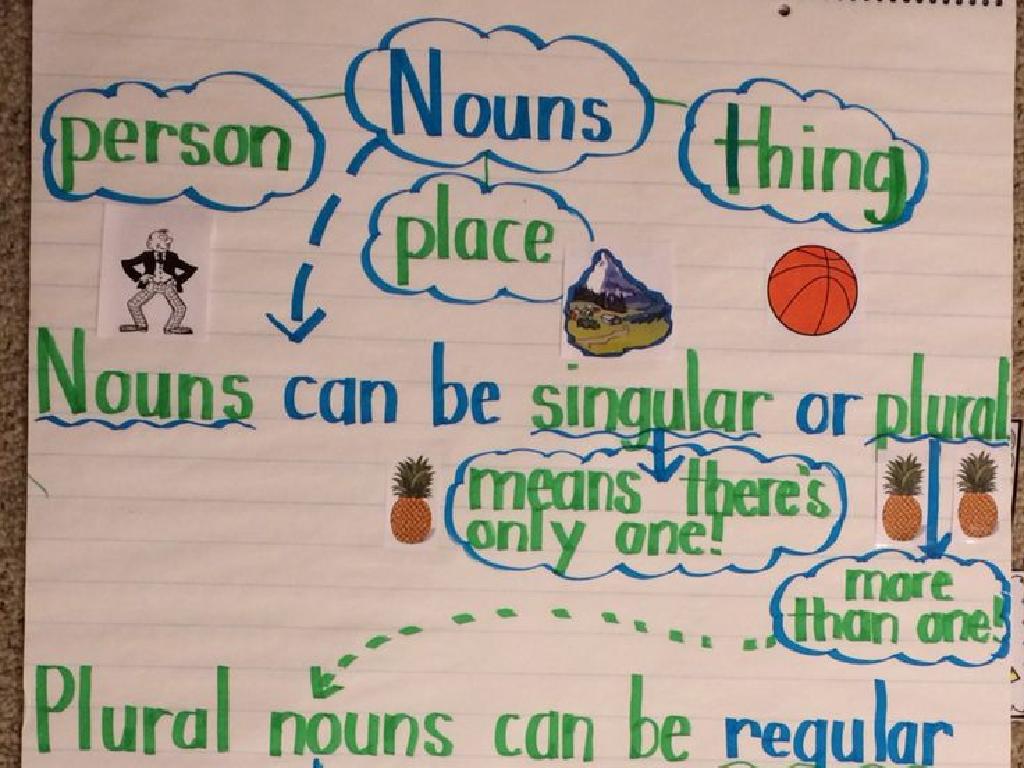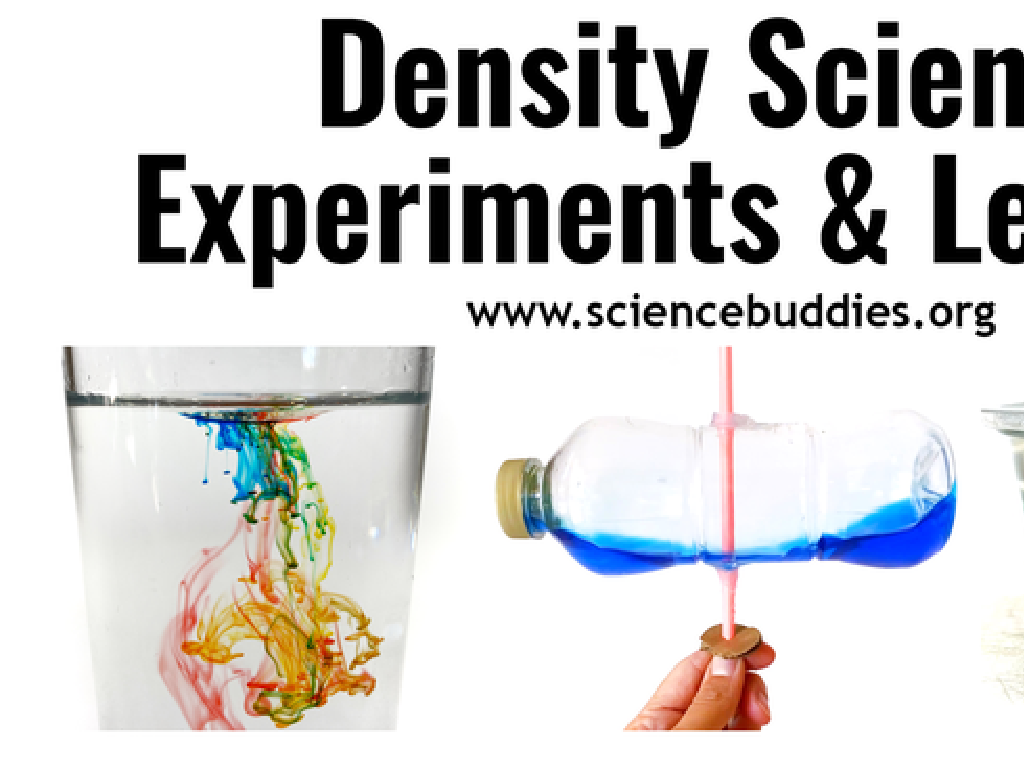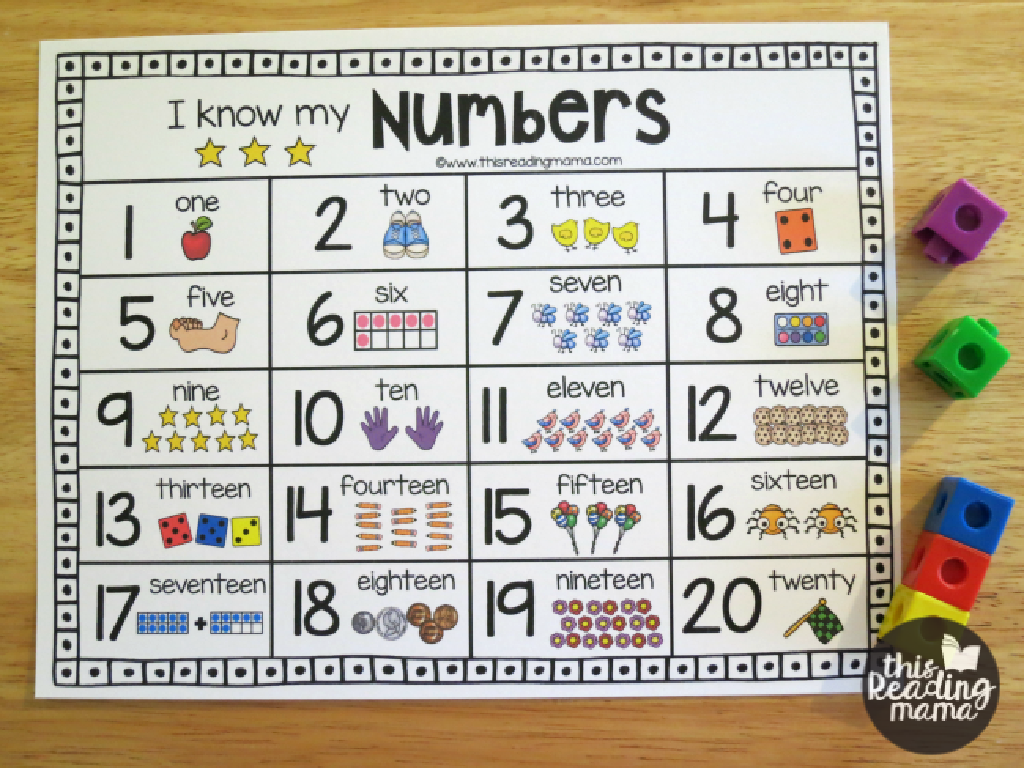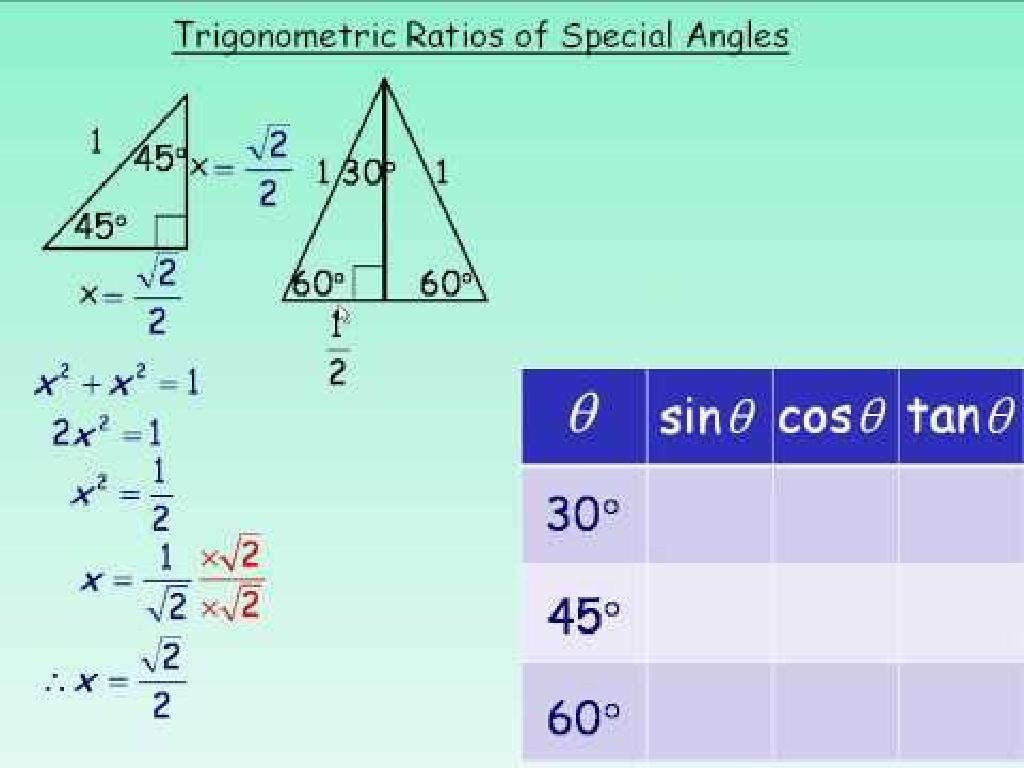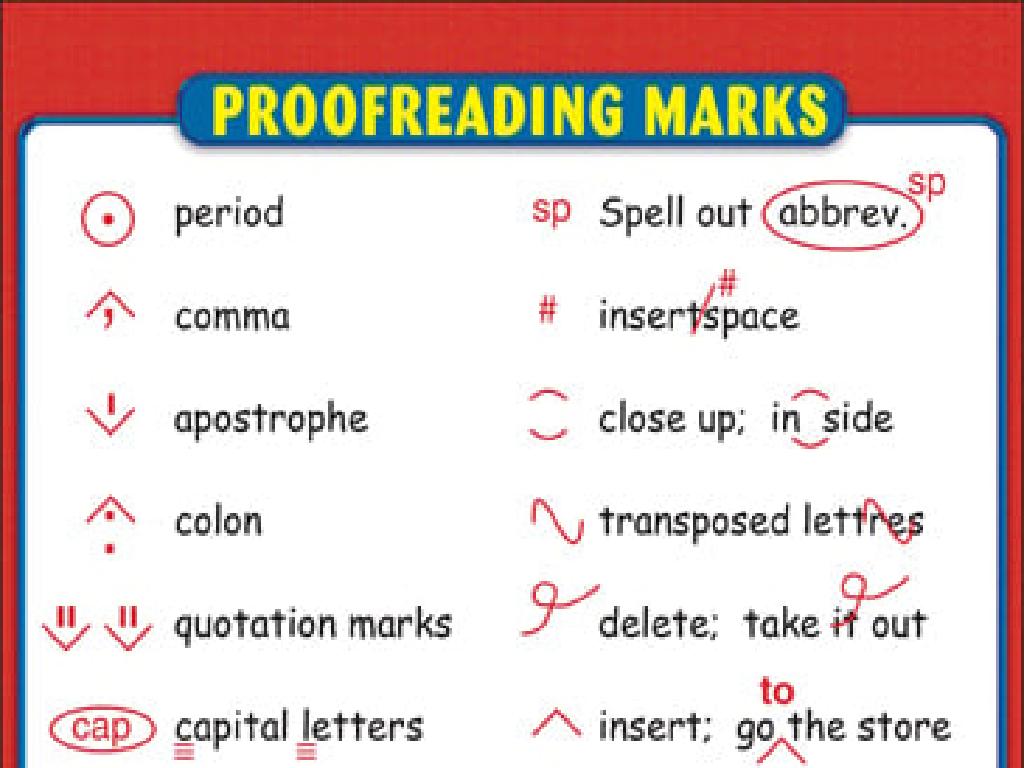How Does Particle Motion Affect Gas Pressure?
Subject: Science
Grade: Eighth grade
Topic: Particle Motion And Energy
Please LOG IN to download the presentation. Access is available to registered users only.
View More Content
Particle Motion and Energy: Gas Pressure
– Particles in gases are always moving
– Imagine tiny particles bouncing in a room, constantly colliding with walls
– Faster motion means higher pressure
– When particles move faster, they hit the walls more often, increasing pressure
– Temperature affects particle speed
– Heating a gas increases particle speed, thus increasing pressure
– Gas pressure is measurable and impactful
|
This slide introduces the concept of particle motion in gases and its effect on gas pressure, a fundamental topic in understanding the behavior of gases. Begin by explaining that gases are made of particles too small to see, but their motion can be understood by imagining a room full of constantly moving balls. Emphasize that the speed of these particles is directly related to the pressure they exert on their container. Discuss how temperature plays a role in particle motion, with higher temperatures leading to faster particles and thus higher pressure. Conclude by explaining that gas pressure is not just a theoretical concept but has practical implications in everyday life, such as in weather systems and how we inflate tires. Encourage students to think of examples where gas pressure is important, and prepare demonstrations or experiments for the next class to visualize these concepts.
Particle Motion in Gases
– Particles move in all matter states
– Gas particles move quickly and freely
– ‘Particle motion’ defined
– Motion of particles in matter
– Particle motion’s role in gas pressure
– Faster motion means more collisions, increasing pressure
|
This slide introduces the concept of particle motion and its significance in understanding gas pressure. Emphasize that in all states of matter, particles are in constant motion. In gases, this motion is rapid and unconfined, allowing particles to move freely in all directions. Define ‘particle motion’ as the movement of these particles within a substance. Explain that the speed and freedom of gas particles’ motion lead to frequent collisions with container walls, which is what we measure as gas pressure. Use examples like a balloon expanding when heated to illustrate how increased particle motion results in higher pressure. This foundational knowledge sets the stage for exploring the relationship between particle motion and gas laws.
Understanding Gas Pressure
– Gas pressure: particles hit container walls
– Particles in gas move freely and collide with walls, similar to balls bouncing in a room.
– Tiny impacts exert force, creating pressure
– Each collision is a small force; all collisions together push on walls and cause pressure.
– More collisions increase pressure
– When particles move faster, they collide more often, which raises the pressure inside the container.
– Analogy: room with bouncing balls
– Visualize a room where balls are thrown faster and more often; the impacts become more frequent.
|
This slide introduces the concept of gas pressure in a way that eighth-grade students can visualize and understand. Gas pressure is the result of countless tiny impacts of gas particles against the walls of their container. Each impact is a force exerted on the wall, and the sum of these forces is what we measure as pressure. To help students grasp this concept, use the analogy of a room filled with bouncing balls. Each ball represents a particle, and each bounce off the wall represents a collision that contributes to the overall pressure. Emphasize that the speed and frequency of these collisions affect the pressure, with more or faster collisions resulting in higher pressure. Encourage students to think about how temperature might affect particle speed and, consequently, gas pressure.
Factors Affecting Gas Pressure
– Temperature’s role in pressure
– Higher temp accelerates particles, raising pressure
– Volume’s impact on gas pressure
– Less volume means more frequent collisions, boosting pressure
– Particle number influences pressure
– More particles result in increased collision frequency, elevating pressure
– Interrelation of factors
|
This slide aims to explain the relationship between particle motion and gas pressure. Emphasize that temperature is a key factor; as it increases, particles move faster and collide more often, leading to higher pressure. Volume also plays a crucial role; a smaller volume for the same amount of gas means particles collide more frequently, which increases pressure. Additionally, the number of particles directly affects pressure; more particles within a space result in more collisions. Highlight that these factors are interrelated and changes in one can affect gas pressure significantly. Use examples like inflating a balloon to illustrate how temperature and volume affect pressure.
Particle Motion in Gases: The Balloon Example
– Inflating a balloon adds particles
– More air particles inside raise the pressure
– Heating increases particle speed
– Particles move faster, increasing pressure and expanding the balloon
– Faster particles raise pressure
– Higher speed of particles colliding with balloon walls causes higher pressure
– Predict: A balloon in the freezer?
|
This slide uses the familiar example of balloons to illustrate how particle motion affects gas pressure. When a balloon is inflated, the number of air particles inside increases, which raises the pressure due to more frequent collisions with the balloon’s inner walls. Heating the balloon energizes the particles, causing them to move faster and collide more forcefully, thus increasing the pressure and causing the balloon to expand. Conversely, we can predict that placing a balloon in the freezer will slow down the particle motion, resulting in decreased pressure and a shrunken balloon. Encourage students to think critically about the state of particles at different temperatures and how this affects pressure. This will help them understand the kinetic molecular theory and the behavior of gases in various conditions.
Understanding Gas Laws
– Boyle’s Law explained
– Pressure decreases as volume increases at constant temperature.
– Charles’s Law explained
– Volume increases with temperature at constant pressure.
– Relationship between pressure, volume, and temperature
– Predicting gas pressure changes
– Use these laws to predict changes in gas pressure due to volume and temperature.
|
This slide introduces students to Boyle’s Law and Charles’s Law, which are fundamental in understanding the behavior of gases. Boyle’s Law states that at a constant temperature, the pressure of a gas is inversely proportional to its volume. This means if you decrease the volume of a gas, its pressure will increase, provided the temperature doesn’t change. Charles’s Law states that at a constant pressure, the volume of a gas is directly proportional to its temperature. So, if you heat a gas, its volume will increase if the pressure remains unchanged. These concepts are crucial for predicting how gas pressure will change in different situations, such as inflating a balloon or using a syringe. Encourage students to think of everyday examples where these laws apply and to practice problems that involve calculating changes in gas pressure, volume, and temperature.
Experiment Time: Temperature and Gas Pressure
– Observe gas pressure changes
– Gather materials for the experiment
– Small balloon, bottle, hot water, ice water
– Predict balloon’s reaction to temperature
– Will the balloon expand or contract in hot water? What about in ice water?
– Record observations
|
This class activity is designed to help students understand the relationship between temperature and gas pressure. The materials needed for this experiment are simple: a small balloon, a bottle, hot water, and ice water. Before conducting the experiment, ask students to make predictions about what will happen to the balloon when the bottle is placed in hot water and then in ice water. Will the balloon inflate or deflate? Why? After the predictions, perform the experiment. Place the balloon over the bottle, submerge in hot water, and observe. Then, move the bottle to ice water and observe any changes. Discuss the results with the class to reinforce the concept that increased temperature increases particle motion, which in turn increases gas pressure, causing the balloon to expand. Conversely, decreased temperature slows particle motion, decreasing gas pressure, and the balloon contracts. Possible activities include having different groups test different temperatures or having each student record their observations and compare results.
Conclusion: Particle Motion and Gas Pressure
– Observations from the experiment
– Recap the experiment’s key outcomes
– Relation to particle motion
– Faster particles hit walls more often, increasing pressure
– Gas pressure understanding
– Understanding pressure helps explain everyday phenomena like inflating balloons
– Real-world applications
|
In concluding our lesson on particle motion and gas pressure, we’ll discuss the observations made during the class experiment. Students should understand that increased motion of particles results in more frequent collisions with container walls, thereby increasing pressure. This concept is pivotal in explaining various real-world applications, such as why a balloon expands when air is pumped into it. Encourage students to think of other examples where this knowledge is applicable, such as in weather systems or cooking with pressure cookers. This discussion will help solidify their understanding of the relationship between particle motion and gas pressure.
Homework: Particle Motion and Gas Pressure
– Complete the worksheet provided
– Find a real-life application
– Think about weather balloons, aerosol cans, or car tires
– Write a paragraph on your finding
– Describe how particle motion affects gas pressure in the example
– Discuss your findings in class
|
This homework assignment is designed to reinforce the concepts learned about how particle motion affects gas pressure. The worksheet will provide structured questions and problems for students to solve, ensuring they understand the relationship between particle motion and pressure. Encourage students to look for real-life applications that illustrate this concept, such as the expansion of a weather balloon due to increased air temperature, the pressure inside an aerosol can, or how temperature changes affect the pressure in car tires. This will help them connect the theoretical knowledge to practical examples. In the next class, a discussion will allow students to share their findings and learn from each other’s insights, fostering a collaborative learning environment.

